
|
Astronomy Picture Of the Day (APOD)
 Orionids in Taurus
Orionids in Taurus
25.10.2023
History's first known periodic comet, Comet Halley (1P/Halley), returns to the inner Solar System every 76 years or so. The famous comet made its last appearance to the naked-eye in 1986. But dusty...
 APOD: 2023 October 25 B Gone in 60 Seconds: A Green Flash Sunset
APOD: 2023 October 25 B Gone in 60 Seconds: A Green Flash Sunset
24.10.2023
In 60 seconds, this setting Sun will turn green. Actually, the top of the Sun already appears not only green, but wavey -- along with all of its edges. The Sun itself is unchanged -- both effects are caused by looking along hot and cold layers in Earth's atmosphere.
 APOD: 2023 October 24 B Arp 87: Merging Galaxies from Hubble
APOD: 2023 October 24 B Arp 87: Merging Galaxies from Hubble
23.10.2023
This dance is to the death. As these two large galaxies duel, a cosmic bridge of stars, gas, and dust currently stretches over 75,000 light-years and joins them. The bridge itself is strong evidence that these two immense star systems have passed close to each other and experienced violent tides induced by mutual gravity.
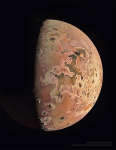 APOD: 2023 October 23 B Moon Io from Spacecraft Juno
APOD: 2023 October 23 B Moon Io from Spacecraft Juno
22.10.2023
There goes another one! Volcanoes on Jupiter's moon Io keep erupting. To investigate, NASA's robotic Juno spacecraft has begun a series of visits to this very strange moon. Io is about...
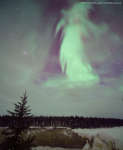 APOD: 2023 October 22 B Ghost Aurora over Canada
APOD: 2023 October 22 B Ghost Aurora over Canada
21.10.2023
What does this aurora look like to you? While braving the cold to watch the skies above northern Canada early one morning in 2013, a most unusual aurora appeared. The aurora definitely appeared to be shaped like something, but what?
 Quarter Moons
Quarter Moons
20.10.2023
Half way between New Moon and Full Moon is the Moon's first quarter phase. That's a quarter of the way around its moonthly orbit. At the first quarter phase, half the Moon's visible side is illuminated by sunlight.
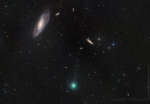 Galaxies and a Comet
Galaxies and a Comet
19.10.2023
Galaxies abound in this sharp telescopic image recorded on October 12 in dark skies over June Lake, California. The celestial scene spans nearly 2 degrees within the boundaries of the well-trained northern constellation Canes Venatici.
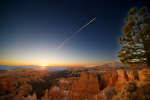 A Sunrise at Sunset Point
A Sunrise at Sunset Point
18.10.2023
This timelapse series captured on October 14 is set against the sunrise view from Sunset Point, Bryce Canyon, planet Earth. Of course on that date the New Moon caught up with the Sun in the canyon's morning skies.
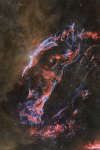 APOD: 2023 October 18 B Dust and the Western Veil Nebula
APOD: 2023 October 18 B Dust and the Western Veil Nebula
17.10.2023
It's so big it is easy to miss. The entire Veil Nebula spans six times the diameter of the full moon, but is so dim you need binoculars to see it. The nebula was created about 15,000 years ago when a star in the constellation of the Swan (Cygnus) exploded.
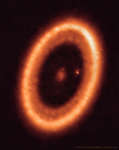 APOD: 2023 October 17 B PDS 70: Disk, Planets, and Moons
APOD: 2023 October 17 B PDS 70: Disk, Planets, and Moons
16.10.2023
It's not the big ring that's attracting the most attention. Although the big planet-forming ring around the star PDS 70 is clearly imaged and itself quite interesting. It's also not the planet on the right, just inside the big disk, thatBs being talked about the most.
|
January February March April May June |
|||||||||||||||||||||||||||||||||||||||||||||||||